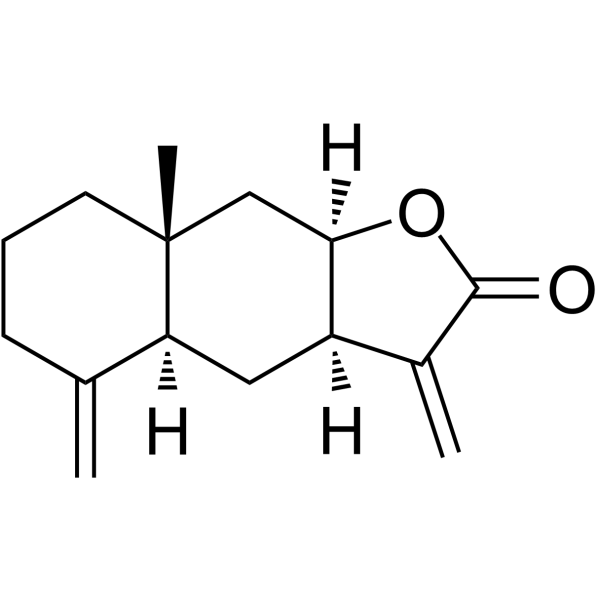上海金畔生物科技有限公司提供天然产物萜类及其苷类Terpenoids and Glycosides。
Isoalantolactone (Synonyms: 异土木香内酯; (+)-Isoalantolactone; Isohelenin) 纯度: 99.99%
Isoalantolactone 是一种烷化剂,用作细胞凋亡 (apoptosis) 诱导剂。

Isoalantolactone Chemical Structure
CAS No. : 470-17-7
| 规格 | 价格 | 是否有货 | 数量 |
|---|---|---|---|
| 10 mM * 1 mL in DMSO | ¥715 | In-stock | |
| 10 mg | ¥650 | In-stock | |
| 50 mg | ¥1500 | In-stock | |
| 100 mg | 询价 | ||
| 200 mg | 询价 |
* Please select Quantity before adding items.
Isoalantolactone 相关产品
•相关化合物库:
- Covalent Screening Library Plus
- Natural Product Library Plus
- Bioactive Compound Library Plus
- Anti-Infection Compound Library
- Apoptosis Compound Library
- Metabolism/Protease Compound Library
- Natural Product Library
- Anti-Cancer Compound Library
- Autophagy Compound Library
- Human Endogenous Metabolite Compound Library
- Covalent Screening Library
- Antibacterial Compound Library
- Terpenoids Library
- Traditional Chinese Medicine Monomer Library
- Food-Sourced Compound Library
| 生物活性 |
Isoalantolactone is an apoptosis inducer, which also acts as an alkylating agent. |
||||||||||||||||
|---|---|---|---|---|---|---|---|---|---|---|---|---|---|---|---|---|---|
| IC50 & Target |
|
||||||||||||||||
| 体外研究 (In Vitro) |
Isoalantolactone exhibits good cytotoxic activity against the K562 human leukaemia cell line (IC50=1.2 μM) [1]. The cytotoxic effect of Isoalantolactone on pancreatic carcinoma is evaluated using PANC-1, BxPC3 and HPAC cell lines. Treatment with Isoalantolactone for 24 h inhibits PANC-1 cell growth in a dose-dependent manner. The inhibition rate is above 90% at 80 µM and the concentration to achieve 50% growth inhibition (IC50) is 40 µM. A similar trend in loss of cell viability is observed in BxPC3 and HPAC cells on Isoalantolactone treatment with IC50 values 43 and 48 µM respectively. Pretreatment with 3 mM N-Acetyl Cysteine (NAC), a specific ROS scavenger, restores the viability of cells indicating that Isoalantolactone exerts cytotoxic effect on cell viability through ROS generation[2]. Shanghai Jinpan Biotech Co Ltd has not independently confirmed the accuracy of these methods. They are for reference only. |
||||||||||||||||
| 体内研究 (In Vivo) |
The acute and chronic toxic effects of Isoalantolactone in CD1 mice are assessed by measuring the changes in body weight, blood biochemistry and histopathology of liver and kidneys in comparison with control groups. Isoalantolactone is well tolerated by mice and no mortality or any sign of pharmacotoxicity are found at a dose of 100 mg/kg during both experimental periods (7 & 30 days). Body weight gains and food consumption are comparable for control and treated mice during both experimental periods and there were no drug-related changes in histopathological and blood biochemistry parameters. The histopathological changes in liver and kidneys are assessed using hematoxylin and eosin staining and correlated with liver and renal function biomarkers. No obvious morphological changes are observed in liver and kidney structures of control and treatment groups. There is a slight increase in serum alanine aminotransferase (ALT) and aspartate aminotransferase (AST) level of treatment group at dose day 7 but this increase is not significantly different (P<0.05) from control group. A significant increase in total bilirubin (TBIL) concentration is found in treatment group (1.43±0.26 vs 0.76±0.12 in control, P<0.05) at dose day 7. Similarly the changes in renal function biomarkers are not significantly different (P<0.05) in the serum of control and treatment groups at dose day 7. The concentration of creatinine (Cr) slightly increases whereas concentration of blood urea nitrogen (BUN) slightly decreases in treatment group. The serum level of AST, ALT, TBIL and BUN slightly decreases when mice are injected with Isoalantolactone at a dose of 100 mg/kg for 30 days[2]. Shanghai Jinpan Biotech Co Ltd has not independently confirmed the accuracy of these methods. They are for reference only. |
||||||||||||||||
| 分子量 |
232.32 |
||||||||||||||||
| Formula |
C15H20O2 |
||||||||||||||||
| CAS 号 |
470-17-7 |
||||||||||||||||
| 中文名称 |
异土木香内酯;异阿兰内酯 |
||||||||||||||||
| 运输条件 |
Room temperature in continental US; may vary elsewhere. |
||||||||||||||||
| 储存方式 |
|
||||||||||||||||
| 溶解性数据 |
In Vitro:
DMSO : 100 mg/mL (430.44 mM; Need ultrasonic) 配制储备液
*
请根据产品在不同溶剂中的溶解度选择合适的溶剂配制储备液;一旦配成溶液,请分装保存,避免反复冻融造成的产品失效。 In Vivo:
请根据您的实验动物和给药方式选择适当的溶解方案。以下溶解方案都请先按照 In Vitro 方式配制澄清的储备液,再依次添加助溶剂: ——为保证实验结果的可靠性,澄清的储备液可以根据储存条件,适当保存;体内实验的工作液,建议您现用现配,当天使用; 以下溶剂前显示的百
|
||||||||||||||||
| 参考文献 |
|
| Cell Assay [2] |
Cell viability is assessed by MTT assay. Briefly PANC-1, BxPC3, and HPAC cells are treated with DMSO or Isoalantolactone (5, 10, 20, 40, 80 and 100 μM) in the presence or absence of 3 mM NAC for 24 h. Following treatment, the MTT reagent is added (500 µg/mL) and cells are further incubated at 37°C for 4 h. Subsequently 150 μL DMSO is added to dissolve farmazan crystals and absorbance is measured at 570 nm in a microplate reader. The percentage of cell viability is calculated[2]. Shanghai Jinpan Biotech Co Ltd has not independently confirmed the accuracy of these methods. They are for reference only. |
|---|---|
| Animal Administration [2] |
Mice[2] Shanghai Jinpan Biotech Co Ltd has not independently confirmed the accuracy of these methods. They are for reference only. |
| 参考文献 |
|
